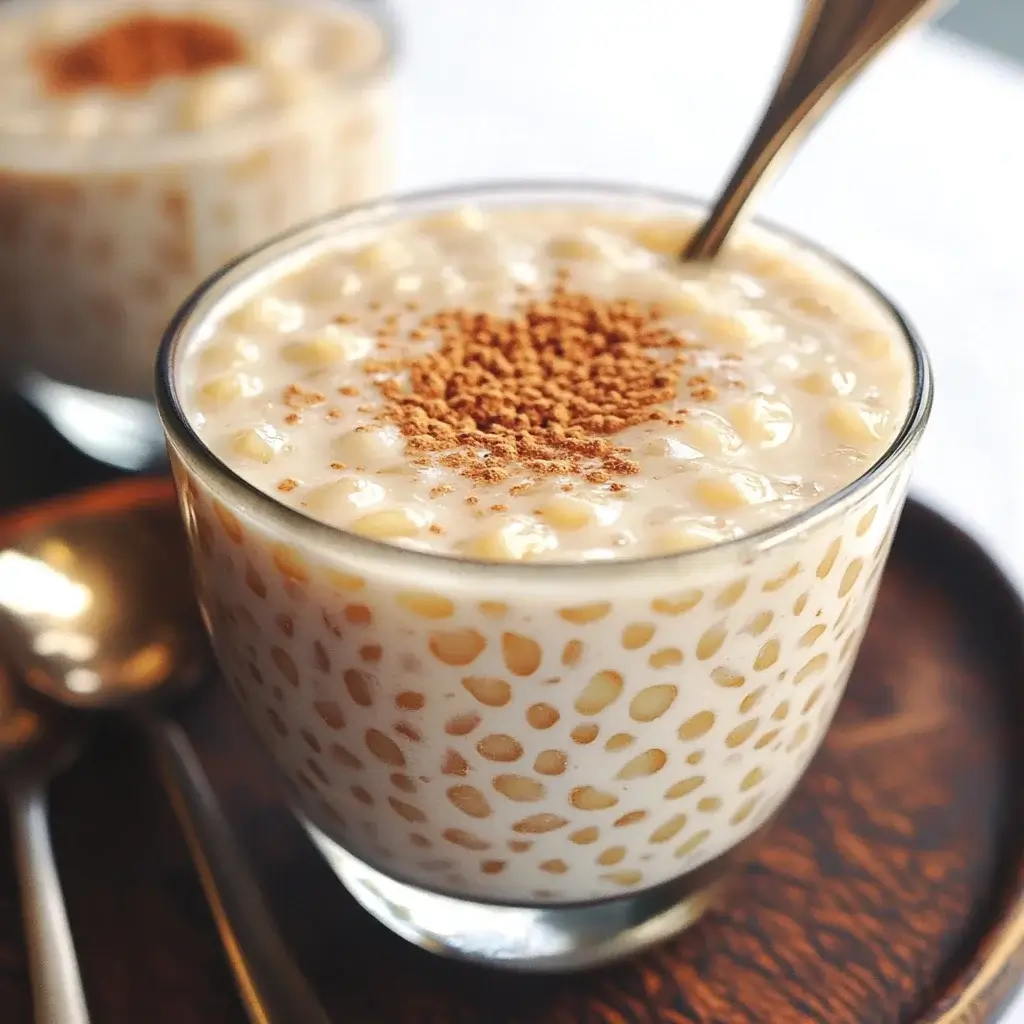Let’s dive into the delightful world of homemade desserts, shall we? There are some recipes that just transport you back to simpler times, evoking a sense of warmth and comfort with every spoonful. For me, Creamy Coconut Tapioca Pudding is one of those magical dishes. Growing up, my grandmother used to make tapioca pudding on chilly evenings, and the whole house would fill with the sweet, comforting aroma of coconut and vanilla. Trying to recreate that nostalgic flavor led me on a quest to perfect this recipe, and after countless attempts, I can confidently say I’ve nailed it. This Creamy Coconut Tapioca Pudding is not just a dessert; it’s an experience. The incredibly smooth, luscious texture combined with the rich, tropical flavor of coconut is simply irresistible. My family absolutely adores it, and it has become a staple request for potlucks and gatherings. Even those who claim they aren’t pudding fans find themselves coming back for seconds. It’s surprisingly light yet satisfying, making it the perfect sweet treat any time of year. If you’re looking for a dessert that’s easy to make, utterly delicious, and guaranteed to impress, look no further. This Creamy Coconut Tapioca Pudding is about to become your new favorite indulgence.
Ingredients for Creamy Coconut Tapioca Pudding
Small Pearl Tapioca: 1/2 cup. These tiny pearls are the heart of our pudding, providing that signature chewy, yet melt-in-your-mouth texture. Make sure to use small pearl tapioca for the best consistency; large pearl tapioca will require different cooking times and might not yield the same creamy result.
Full-Fat Coconut Milk: 2 cans (13.5 oz each). The star ingredient that infuses the pudding with its rich coconut flavor and creamy texture. Opt for full-fat coconut milk for the most decadent and flavorful pudding. Light coconut milk will work, but the pudding won’t be as rich and creamy.
Milk (Dairy or Non-Dairy): 2 cups. Milk adds extra liquid and creaminess to the pudding. You can use dairy milk (whole milk or 2%) for a classic flavor, or choose a non-dairy alternative like almond milk, soy milk, or oat milk to keep it vegan or cater to dietary preferences. The choice of milk will subtly influence the final flavor profile.
Sugar: 1/2 cup (granulated). Sweetness is key in a pudding, and granulated sugar provides the perfect level of sweetness to balance the coconut flavor. You can adjust the amount of sugar to your preference, but this amount is generally considered just right.
Egg Yolks: 2 large. Egg yolks enrich the pudding, adding a velvety smooth texture and a subtle richness. They also contribute to the pudding’s thickening process, creating a more stable and luxurious consistency.
Vanilla Extract: 1 teaspoon. A touch of vanilla extract enhances the overall flavor profile of the pudding, adding warmth and complexity. Use pure vanilla extract for the best flavor; avoid imitation vanilla for a more authentic taste.
Pinch of Salt: Just a small pinch to balance the sweetness and enhance all the other flavors in the pudding. Salt is a flavor enhancer and plays a crucial role in bringing out the best in sweet dishes.
Instructions for Making Creamy Coconut Tapioca Pudding
- Soak the Tapioca: In a medium saucepan, combine the small pearl tapioca with 2 cups of water. Let it soak for at least 30 minutes, or even better, for 1-2 hours. Soaking softens the tapioca pearls, which helps them cook more evenly and achieve that perfect chewy-yet-tender texture. This step is crucial for preventing the tapioca from being hard or grainy in the final pudding. If you are short on time, a 30-minute soak is acceptable, but longer soaking will yield a smoother result.
- Combine Ingredients and Heat: After soaking, add the coconut milk, milk (dairy or non-dairy), sugar, and salt to the saucepan with the soaked tapioca. Stir everything together well to ensure the sugar is dissolved. Place the saucepan over medium heat and bring the mixture to a gentle simmer. Stir frequently to prevent the tapioca from sticking to the bottom of the pan and burning. Maintaining a gentle simmer is important; boiling too vigorously can cause the milk to scald and the pudding to become grainy.
- Cook the Tapioca: Continue to simmer the mixture, stirring constantly, for about 15-20 minutes, or until the tapioca pearls become translucent and the pudding starts to thicken slightly. The tapioca pearls should lose their opaque white color and become clear. The pudding will still be quite thin at this stage, but it will thicken further as it cools and when we add the egg yolks. It’s important to keep stirring throughout this process to ensure even cooking and prevent sticking.
- Temper the Egg Yolks: In a small bowl, whisk the egg yolks until they are slightly pale and smooth. Tempering the egg yolks prevents them from scrambling when added to the hot pudding. To temper, slowly drizzle a few tablespoons of the hot pudding mixture into the whisked egg yolks, whisking constantly. This gradually raises the temperature of the yolks. Repeat this process two or three times, adding a little more hot pudding each time and whisking continuously.
- Incorporate Egg Yolks and Cook Further: Pour the tempered egg yolk mixture back into the saucepan with the rest of the pudding. Reduce the heat to low and continue to cook, stirring constantly, for another 5-7 minutes, or until the pudding thickens to your desired consistency and coats the back of a spoon. Be careful not to boil the pudding after adding the egg yolks, as this can cause them to curdle. The pudding should thicken noticeably during this stage and become creamy and smooth. If you prefer a thicker pudding, you can cook it for a minute or two longer, but be mindful not to overcook it.
- Add Vanilla Extract and Cool: Remove the saucepan from the heat and stir in the vanilla extract. Vanilla is best added at the end of cooking to preserve its delicate flavor. Allow the pudding to cool slightly at room temperature before transferring it to individual serving dishes or a larger bowl. As the pudding cools, it will continue to thicken.
- Chill and Serve: Cover the pudding with plastic wrap, pressing the plastic wrap directly onto the surface of the pudding to prevent a skin from forming. Refrigerate for at least 2-3 hours, or preferably overnight, to allow the pudding to fully chill and set. Chilling is essential for achieving the perfect creamy texture and allowing the flavors to meld together. Serve chilled and enjoy the creamy, coconutty goodness!
Nutrition Facts (per serving, approximate)
Servings: 6
Calories per serving: Approximately 280-320 kcal (depending on milk and sugar levels)
Fat: 18-22g
Saturated Fat: 14-17g
Cholesterol: 60-70mg
Note: Nutritional values are estimates and can vary based on specific ingredients used and portion sizes.
Preparation Time
Prep Time: 15 minutes (plus soaking time: 30 minutes to 2 hours)
Cook Time: 30 minutes
Chill Time: 2-3 hours (or overnight)
Total Time: Approximately 3 hours (including chilling)
How to Serve Creamy Coconut Tapioca Pudding
- Classic Chilled: The most traditional way to enjoy tapioca pudding is chilled straight from the refrigerator. The cool, creamy texture is incredibly refreshing and satisfying, especially on a warm day.
- Warm Pudding (Slightly Cooled): If you prefer a warmer dessert, you can serve the pudding slightly cooled, just after it has thickened but before it’s fully chilled. It will have a softer, more spoonable texture when served warm.
- Topped with Fresh Fruit: Elevate your pudding with a vibrant burst of freshness by topping it with seasonal fruits. Berries like strawberries, raspberries, and blueberries pair beautifully with the coconut flavor. Sliced mango or pineapple can enhance the tropical notes.
- Sprinkled with Toasted Coconut: For an extra layer of coconut flavor and a delightful textural crunch, sprinkle toasted coconut flakes on top of the pudding. Toasting the coconut brings out its nutty aroma and adds a beautiful golden color.
- Dollop of Whipped Cream: A classic pairing for pudding, a dollop of lightly sweetened whipped cream adds extra richness and a cloud-like texture. You can also use coconut whipped cream for an intensified coconut flavor and a vegan option.
- Drizzle of Caramel Sauce: For a decadent twist, drizzle a bit of homemade or store-bought caramel sauce over the pudding. The buttery sweetness of caramel complements the coconut beautifully.
- Garnish with Mint Leaves: A sprig of fresh mint not only adds a pop of color but also provides a refreshing counterpoint to the richness of the pudding. It’s a simple yet elegant garnish.
- Layered Dessert Parfait: Create an elegant dessert parfait by layering the creamy coconut tapioca pudding with crushed graham crackers, fresh fruit, and whipped cream in glasses. This makes for a visually appealing and delicious dessert.
Additional Tips for Perfect Tapioca Pudding
- Don’t Skip Soaking: Soaking the tapioca is a critical step for achieving the right texture. It allows the pearls to soften and hydrate, ensuring they cook evenly and become tender. Skipping this step can result in hard, undercooked tapioca pearls in your pudding.
- Stir Constantly While Cooking: Tapioca pudding requires frequent stirring, especially during the cooking process. This prevents the tapioca from sticking to the bottom of the pan and burning, and it also ensures even heat distribution for smooth and consistent thickening.
- Adjust Sweetness to Your Taste: The recipe calls for 1/2 cup of sugar, but you can adjust this amount to suit your personal preference. If you prefer a less sweet pudding, start with 1/3 cup and taste as you go. If you like it sweeter, you can add a bit more.
- Use Full-Fat Coconut Milk for Richness: For the creamiest and most flavorful coconut tapioca pudding, full-fat coconut milk is highly recommended. Light coconut milk will work, but the pudding will lack some of the richness and depth of flavor. If you are using full-fat coconut milk that has separated in the can, make sure to stir it well before using.
- Don’t Boil After Adding Egg Yolks: Once you add the tempered egg yolks to the pudding, it’s crucial to keep the heat low and avoid boiling. Boiling can cause the egg yolks to curdle and ruin the smooth texture of the pudding. Gentle simmering is key at this stage.
- Cool Completely Before Serving: Tapioca pudding is best enjoyed chilled. Allowing it to cool completely in the refrigerator not only enhances the flavor but also allows the pudding to set properly and achieve its signature creamy texture. Chilling for at least 2-3 hours, or overnight, is recommended.
Frequently Asked Questions (FAQ) about Creamy Coconut Tapioca Pudding
Q1: Can I use large pearl tapioca instead of small pearl tapioca?
A: While technically you can use large pearl tapioca, it’s not recommended for this recipe as it will require a significantly longer soaking and cooking time. Large pearl tapioca also tends to have a chewier texture, which might not be ideal for a creamy pudding. Small pearl tapioca is specifically designed for pudding and provides the best texture and consistency. If you only have large pearl tapioca, you will need to soak it for several hours or even overnight and cook it for a much longer duration, checking for translucency and tenderness. The texture will still be different from pudding made with small pearls.
Q2: Can I make this pudding vegan?
A: Yes, you can easily make this coconut tapioca pudding vegan by making a few simple substitutions. First, replace the dairy milk with a plant-based milk like almond milk, soy milk, oat milk, or even more coconut milk for an intensified coconut flavor. Second, the egg yolks provide richness and thickening. To replace them in a vegan version, you can use a cornstarch slurry (1 tablespoon cornstarch mixed with 2 tablespoons cold water) added towards the end of cooking to thicken the pudding. Alternatively, some vegan recipes use full-fat coconut cream or silken tofu to add creaminess. Remember to check that your vanilla extract is also vegan-friendly.
Q3: How long does coconut tapioca pudding last in the refrigerator?
A: Properly stored in an airtight container in the refrigerator, coconut tapioca pudding will last for about 3-4 days. It’s best to consume it within this timeframe for optimal flavor and texture. As with any homemade pudding, it’s always a good idea to check for any signs of spoilage before eating, such as an off smell or changes in texture or color.
Q4: Can I freeze tapioca pudding?
A: Freezing tapioca pudding is generally not recommended as it can alter the texture significantly. When thawed, the pudding may become watery or grainy due to the tapioca pearls and the dairy components separating. The creamy texture is likely to be compromised. For the best quality and texture, it’s best to make tapioca pudding fresh and enjoy it within a few days of preparation.
Q5: My tapioca pudding is too thick or too thin. How can I fix it?
A: If your tapioca pudding is too thick, you can thin it out by gently stirring in a little more milk (dairy or non-dairy) or coconut milk, a tablespoon at a time, until it reaches your desired consistency. If your pudding is too thin, and you haven’t added egg yolks yet, you can continue to simmer it over low heat, stirring constantly, to allow it to thicken further. If you’ve already added egg yolks and it’s still too thin, be cautious about overcooking, as boiling can cause curdling. In this case, a very small amount of cornstarch slurry (as mentioned in the vegan question) could be gently stirred in and cooked for a minute or two to thicken it slightly, but be mindful not to add too much.
Q6: Can I add other flavors to this coconut tapioca pudding?
A: Absolutely! Coconut tapioca pudding is a versatile base for other flavors. You can enhance the tropical theme by adding a teaspoon of coconut extract along with the vanilla extract. For a different flavor profile, consider adding a pinch of ground cinnamon or nutmeg. You could also incorporate citrus zest, such as lime or orange zest, for a brighter flavor. For a richer, chocolatey twist, stir in a couple of tablespoons of cocoa powder for a coconut chocolate tapioca pudding. Be creative and experiment with your favorite flavor combinations to customize your pudding!
Print
Creamy Coconut Tapioca Pudding
Ingredients
Small Pearl Tapioca: 1/2 cup. These tiny pearls are the heart of our pudding, providing that signature chewy, yet melt-in-your-mouth texture. Make sure to use small pearl tapioca for the best consistency; large pearl tapioca will require different cooking times and might not yield the same creamy result.
Full-Fat Coconut Milk: 2 cans (13.5 oz each). The star ingredient that infuses the pudding with its rich coconut flavor and creamy texture. Opt for full-fat coconut milk for the most decadent and flavorful pudding. Light coconut milk will work, but the pudding won’t be as rich and creamy.
Milk (Dairy or Non-Dairy): 2 cups. Milk adds extra liquid and creaminess to the pudding. You can use dairy milk (whole milk or 2%) for a classic flavor, or choose a non-dairy alternative like almond milk, soy milk, or oat milk to keep it vegan or cater to dietary preferences. The choice of milk will subtly influence the final flavor profile.
Sugar: 1/2 cup (granulated). Sweetness is key in a pudding, and granulated sugar provides the perfect level of sweetness to balance the coconut flavor. You can adjust the amount of sugar to your preference, but this amount is generally considered just right.
Egg Yolks: 2 large. Egg yolks enrich the pudding, adding a velvety smooth texture and a subtle richness. They also contribute to the pudding’s thickening process, creating a more stable and luxurious consistency.
Vanilla Extract: 1 teaspoon. A touch of vanilla extract enhances the overall flavor profile of the pudding, adding warmth and complexity. Use pure vanilla extract for the best flavor; avoid imitation vanilla for a more authentic taste.
Pinch of Salt: Just a small pinch to balance the sweetness and enhance all the other flavors in the pudding. Salt is a flavor enhancer and plays a crucial role in bringing out the best in sweet dishes.
Instructions
- Soak the Tapioca: In a medium saucepan, combine the small pearl tapioca with 2 cups of water. Let it soak for at least 30 minutes, or even better, for 1-2 hours. Soaking softens the tapioca pearls, which helps them cook more evenly and achieve that perfect chewy-yet-tender texture. This step is crucial for preventing the tapioca from being hard or grainy in the final pudding. If you are short on time, a 30-minute soak is acceptable, but longer soaking will yield a smoother result.
- Combine Ingredients and Heat: After soaking, add the coconut milk, milk (dairy or non-dairy), sugar, and salt to the saucepan with the soaked tapioca. Stir everything together well to ensure the sugar is dissolved. Place the saucepan over medium heat and bring the mixture to a gentle simmer. Stir frequently to prevent the tapioca from sticking to the bottom of the pan and burning. Maintaining a gentle simmer is important; boiling too vigorously can cause the milk to scald and the pudding to become grainy.
- Cook the Tapioca: Continue to simmer the mixture, stirring constantly, for about 15-20 minutes, or until the tapioca pearls become translucent and the pudding starts to thicken slightly. The tapioca pearls should lose their opaque white color and become clear. The pudding will still be quite thin at this stage, but it will thicken further as it cools and when we add the egg yolks. It’s important to keep stirring throughout this process to ensure even cooking and prevent sticking.
- Temper the Egg Yolks: In a small bowl, whisk the egg yolks until they are slightly pale and smooth. Tempering the egg yolks prevents them from scrambling when added to the hot pudding. To temper, slowly drizzle a few tablespoons of the hot pudding mixture into the whisked egg yolks, whisking constantly. This gradually raises the temperature of the yolks. Repeat this process two or three times, adding a little more hot pudding each time and whisking continuously.
- Incorporate Egg Yolks and Cook Further: Pour the tempered egg yolk mixture back into the saucepan with the rest of the pudding. Reduce the heat to low and continue to cook, stirring constantly, for another 5-7 minutes, or until the pudding thickens to your desired consistency and coats the back of a spoon. Be careful not to boil the pudding after adding the egg yolks, as this can cause them to curdle. The pudding should thicken noticeably during this stage and become creamy and smooth. If you prefer a thicker pudding, you can cook it for a minute or two longer, but be mindful not to overcook it.
- Add Vanilla Extract and Cool: Remove the saucepan from the heat and stir in the vanilla extract. Vanilla is best added at the end of cooking to preserve its delicate flavor. Allow the pudding to cool slightly at room temperature before transferring it to individual serving dishes or a larger bowl. As the pudding cools, it will continue to thicken.
- Chill and Serve: Cover the pudding with plastic wrap, pressing the plastic wrap directly onto the surface of the pudding to prevent a skin from forming. Refrigerate for at least 2-3 hours, or preferably overnight, to allow the pudding to fully chill and set. Chilling is essential for achieving the perfect creamy texture and allowing the flavors to meld together. Serve chilled and enjoy the creamy, coconutty goodness!
Nutrition
- Serving Size: one normal portion
- Calories: 320
- Fat: 22g
- Saturated Fat: 17g
- Cholesterol: 70mg






